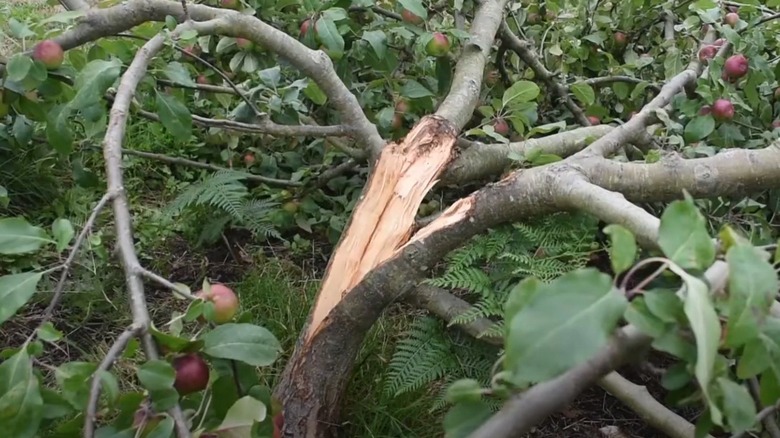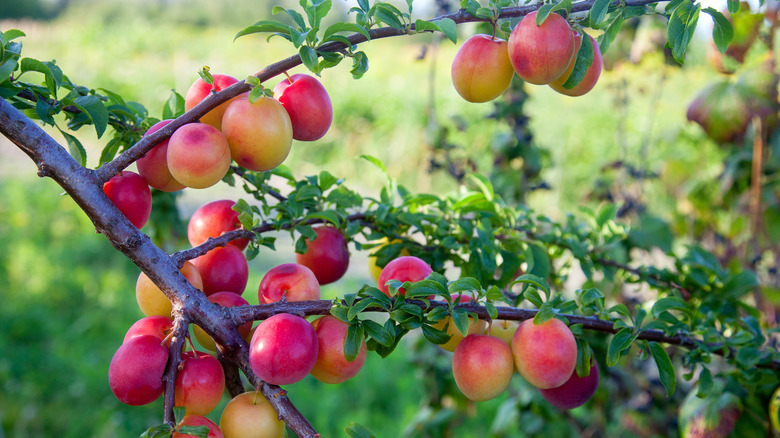The Beautiful Fruit Tree That's Putting Your Home In Danger
When you're looking for drought-resistant trees to plant in your yard that also produce fruit and are beautiful, cherry plum is a popular species. Also called Prunus cerasifera, these trees have white blossoms that appear in early spring and eventually develop into cherry-like fruits that are yellow and red. It's an ornamental tree that attracts bees, butterflies, and other pollinating animals, which is great if you have other plants on the property. It's also an easy tree to grow, which is ideal for novice gardeners and landscapers. Some people even call it one of the perfect flowering trees for the yard.
However, when things seem too good to be true, they sometimes are. The cherry plum has significant issues that could make it dangerous to have near your home. For starters, its wood is weak and could suffer damage if you have stormy conditions at your home, which could kill the tree earlier than expected. Diseases can affect this species, too, such as silver leaf, which is a disease that can spread to other trees and host plants, placing other trees in your yard in danger. When the fruit of the cherry plum falls to the ground, it can be smashed on the sidewalk and potentially become slippery like other smashed fruits. Finally, although the tree's fruit is safe to eat, the seeds, leaves, and bark can all be poisonous to people. That's a long list of potential problems.
Why the cherry plum tree is susceptible to breakage and other damage
Cherry plums have a dark gray bark that is common among fruit trees. Like other stone fruit trees that have thin and dark bark, the cherry plum is susceptible to breakage and trunk splitting. Ice storms in winter and heavy loads of fruit in summer can cause these splits. In addition to a structure that could split, it also has brittle wood that could cause it to die prematurely. With excellent care, it can live 60 to 80 years. However, it's common for the tree to split or break severely well before that, potentially only living 15 to 20 years. If this split happens, it's a key sign that tree removal may be the right choice, although some split trees are repairable with cables and braces.
When the cherry plum tree reaches its full height, it measures 15 to 20 feet. If it falls during a storm or splits in half, the large limbs could cause damage to your home's roof. With this size of tree, the leaves could fall into the gutters and cause clogs and water problems for your foundation, too.
You might also have to remove a cherry plum tree because of how susceptible it is to fungal diseases or insect infestations, although some issues — when caught early — are treatable. Some of the most common diseases for this species can include black knot, leaf spot, powdery mildew, silver leaf, and more. Insects that can affect the cherry plum include Japanese beetles, aphids, borers, and more.
Other potential problems with the cherry plum tree
Beyond the potential for splitting and other broken branches, you might not want cherry plum trees around your house for other reasons. The pulp and skin on the fruit of this tree are safe for people to eat raw or to use in wine, jams, muffins, cakes, pies, and more. However, the pit of the fruit and the leaves and bark of the tree can be toxic. These portions of the cherry plum contain amygdalin, which can lead to fatal cyanide toxicity when consumed. Additionally, the portions of the cherry plum tree that have amygdalin can be very dangerous for dogs, cats, horses, and other pets that ingest them.
When you want a tree that looks similar but avoids the problems with brittle branches and the fruit possibly making people sick, consider a flowering cherry tree. This tree is strictly ornamental as it does not produce any fruit. It creates pink and white blossoms during spring, yielding a beautiful look similar to the cherry plum.
Another similar flowering tree to consider is one of the multiple types of flowering dogwoods. Many of them bloom in both spring and fall, which is an advantage over the cherry plum. If you live in an area with extreme cold, some species can handle temperatures as low as -30 degrees Fahrenheit. Whether or not you decide to go with a cherry plum, knowing the pros and cons can help you make an informed decision.


